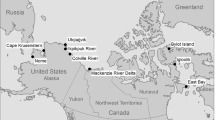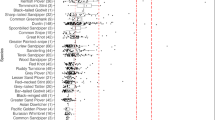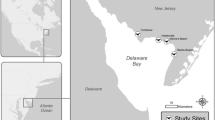Abstract
San Francisco Bay (SFB) estuary sediments contain high levels of mercury (Hg), and tidal marsh resident species may be vulnerable to Hg contamination. We examined Hg concentrations in California black rails, a threatened waterbird species that inhabits SFB tidal salt marshes. We captured 127 black rails during the prebreeding and postbreeding seasons and examined the influence of site, sex, and year on Hg, methylmercury (MeHg), and also selenium (Se) concentrations in feathers and blood. Feather Hg concentrations averaged 6.94 μg/g dry weight (dw) and MeHg and Se concentrations in blood averaged 0.38 and 0.42 μg/g wet weight (ww). We used Akaike’s information criterion model selection process to evaluate the importance of year, site, sex, and age on patterns of MeHg concentrations; sex and year were the most important of these factors. Feather Hg concentrations (dw) were higher in males (8.22 μg/g) than females (6.63 μg/g) and higher in adult birds (7.36 μg/g) than in hatch-year birds (4.61 μg/g). A substantial portion of SFB black rail populations may be at risk of reproductive effects due to MeHg contamination, as 32–78% of feathers and <10% of blood samples exceeded no observed adverse effect levels. Sea level rise and other anthropogenic threats to endemic tidal marsh species such as black rails may be exacerbated by the presence of MeHg. Further study of population demographics and toxicological effects would further elucidate the effects of MeHg contamination on black rail populations in SFB.






Similar content being viewed by others
References
Ackerman JT, Eagles-Smith CA, Takekawa JY et al (2007) Mercury concentrations and space use of pre-breeding American avocets and Black-necked stilts in San Francisco Bay. Sci Total Environ 394:452–466
Anderson DR, Burnham KP, Thompson WL (2000) Null hypothesis testing: problems, prevalence, and an alternative. J Wildl Manage 64:912–923
Atwater BF, Conrad SG, Dowden JN, Hedell CW, Mac-Donald RC, Savage W (1979) History, landforms, and vegetation of the estuary’s tidal marshes. In: Conomos TJ (ed) San Francisco Bay: the urbanized estuary. Pacific Division, American Association for the Advancement of Science, San Francisco, pp 347–385
Balling SS, Resh VH (1991) Seasonal patterns in a San Francisco Bay, California, salt marsh arthropod community. Pan-Pacific Entomol 67:138–144
Becker PH, González-Solís J, Behrends B, Croxall J (2002) Feather mercury levels in seabirds at South Georgia: influence of trophic position, sex, and age. Marine Ecol Prog Ser 243:261–269
Bloom N (1989) Determination of picogram levels of methylmercury by aqueous phase ethylation, followed by cryogenic GC with CVAF detection. Can J Fish Aquat Sci 46:1131–1140
Burger J, Gochfeld M (1997) Risk, mercury levels, and birds: relating adverse laboratory effects to field biomonitoring. Environ Res 75:160–172
Burnham KP, Anderson DR (2003) Model selection and multimodel inference: a practical information-theoretic approach. Springer-Verlag, New York
Champoux L, Masse DC, Evers DC, Lane OP, Plante M, Timmermans STA (2006) Assessment of mercury exposure and potential effects on common loons (Gavia immer) in Quebec. Hydrobiologia 567:263–274
Churchill RK (2000) Contributions of mercury to California’s environment from mercury and gold mining activities; Insights from the historical record. In: Extended abstracts for the US EPA sponsored meeting, Assessing and managing mercury from historic and current mining activities, November 28–30, 2000, San Francisco, pp 33–36
Clinton OE (1977) Determination of selenium in blood and plant material by hydridegeneration and atomic-absorption spectroscopy. Analyst 103:1210–1221
Davis JA, Yee D, Collins JN, Schwarzbach SE, Luoma SN (2003) Potential for increased mercury accumulation in the estuary food web. In: Brown LR (ed) Issues in San Francisco estuary tidal wetlands restoration, vol. 1. San Francisco estuary and watershed science, Pacific Division, American Association for the Advancement of Science, San Francisco. Available from http://repositories.cdlib.org/jmie/sfews/vol1/iss1/art4
Eddleman WR, Flores RE, Legare ML (1994) Black rail (Laterallus jamaicensis). In: Poole A, Gill F (eds) The birds of North America, No. 123. Philadelphia: The Academy of Natural Sciences, Philadelphia/American Ornithology Union, Washington, DC
Eisler R (2000) Handbook of chemical risk assessment: health hazards to humans, plants, and animals, vol. 1–3. Lewis Publishers, Boca Raton, FL
Evens JG, Nur N (2002) California black rails in the San Francisco Bay Region: spatial and temporal variation in distribution and abundance. Bird Popul 6:1–12
Evens JG, Page GW, Stenzel LE, Stallcup RW, Henderson RP (1989) Distribution and abundance of the California black rail (Laterallus jamaicensis coturniculus) in tidal marshes of the San Francisco Bay estuary. Point Reyes Bird Observatory, PRBO Contribution No. 426, Point Reyes, CA
Evens JG, Page GW, Laymon SA, Stallcup RW (1991) Distribution, relative abundance and status of the California black rail in western North America. Condor 93:952–966
Evers DC, Burgess NM, Champoux L et al (2005) Patterns and interpretation of mercury exposure in freshwater avian communities in northeastern North America. Ecotoxicology 17:173–183
Evers DC, Savoy LJ, DeSorbo CR et al (2008) Adverse effects from environmental mercury loads on breeding common loons. Ecotoxicology 17:69–81
Flores RE, Eddelman WR (1995) California black rail use of habitat in southwestern Arizona. J Wildl Manage 59:357–363
Foerster KS, Takekawa JE, Albertson JD (1990) Breeding density, nesting habitat, and predators of the California clapper rail. San Francisco Bay National Wildlife Ref., No. 11640-90-1
Fournier F, Karasov WH, Kenow KP, Meyer MW, Hines RK (2002) The oral bioavailability and toxicokinetics of methylmercury in common loon (Gavia immer) chicks. Comp Biochem Physiol A 133:703–714
Furness RW (1993) Birds as monitors of pollutants. In: Furness RW, Greenwood JJD (eds) Birds as monitors of environmental change. Chapman & Hall, London
Furness RW, Muirhead SJ, Woodburn M (1986) Using bird feathers to measure mercury in the environment: relationships between mercury content and moult. Marine Pollut Bull 17:27–30
Galbraith H, Jones R, Park R et al (2002) Global climate change and sea level rise: potential losses of intertidal habitat for shorebirds. Waterbirds 25:173–183
Goals Project (1999) Baylands ecosystem habitat goals. A report of habitat recommendations prepared by the San Francisco Bay Area Wetlands Ecosystem Goals Project. US Environmental Protection Agency, San Francisco, Calif./S.F. Bay Regional Water Quality Control Board, Oakland, CA
Heinz GH (1979) Methylmercury: reproductive and behavioral effects on three generations of Mallard ducks. J Wildl Manage 43:394–401
Heinz GH (2003) The use of egg injections to rank the sensitivities of avian embryos to methylmercury. Final Progress report to the CALFED Bay-Delta Mercury Project
Heinz GH, Hoffman DJ (1998) Methylmercury chloride and selenomethionine interactions on health and reproduction in mallards. Environ Toxicol Chem 17:139–145
Heinz GH, Hoffman DJ, Gold LG (1989) Impaired reproduction of mallards fed an organic form of selenium. J Wildl Manage 53:418–428
Henny CJ, Hill EF, Hoffman DJ, Spalding MG, Grove RA (2002) Nineteenth century mercury: hazard to wading birds and cormorants of the Carson River, Nevada. Ecotoxicology 11:213–231
Kahle S, Becker PH (1999) Bird blood as bioindicator for mercury in the environment. Chemosphere 39:2451–2457
Legare ML, Eddleman WR (2001) Home range size, nest-site selection and nesting success of black rails in Florida. J Field Ornithol 72:170–177
Manolis T (1978) Status of the black rail in central California. West Birds 9:151–158
Marvin-DiPasquale MC, Agee JL, Bouse RM, Jaffe BE (2003) Microbial cycling of mercury in contaminated pelagic and wetland sediments of San Pablo Bay, California. Environ Geol 43:260–267
Nur N, Zack S, Evens J, Gardali T (1997) Tidal marsh birds of the San Francisco Bay region: status distribution, and conservation of five Category 2 taxa. Report to US Geologic Survey, Biology Research Division
Ohlendorf HM, Harrison CS (1986) Mercury, selenium, cadmium and organochlorines in eggs of three Hawaiian seabird species. Environ Pollut 1:169–191
Pyle P, Howell SNG (in press) Identification guide to North American birds. Part II. Slate Creek Press, Bolinas, CA
Scheuhammer AM (1987) The chronic toxicity of aluminum, cadmium, mercury, and lead in birds: a review. Environ Pollut 46:263–295
Schwarzbach SE, Albertson JD, Thomas CM (2006) Effects of predation, flooding, and contamination on reproductive success of California clapper rails (Rallus longirostris obsoletus) in San Francisco Bay. Auk 123:45–60
Simas T, Nunes JP, Ferreira JG (2001) Effects of global climate change on coastal salt marshes. Ecol Model 139:1–15
Stickel LF, Stickel WH, McLane MAR, Bruns M (1977) Prolonged retention of methyl mercury by mallard drakes. Bull Environ Contam Toxicol 18:393–400
Takekawa JY, Woo I, Spautz H et al (2007) Environmental threats to tidal-marsh vertebrates of the San Francisco Bay estuary. Studies Avian Biol 32:176–197
Thompson DR, Furness RW (1989) A comparison of the levels of total and organic mercury in seabird feathers. Marine Pollut Bull 20:577–579
US EPA (2000) Method 7473, Mercury in solids and solutions by thermal decomposition, amalgamation, and atomic absorption spectrophotometry, Test methods for evaluation solid waste, physical/chemical methods SW 846, Update IVA. US Government Printing Office, Washington, DC
Wilbur SR (1974) Status of the black rail in central California. West Birds 9:151–158
Wiener JG, Gilmour CG, Krabbenhoft DP (2003) Mercury strategy for the bay-delta ecosystem: a unifying framework for science, adaptive management, and ecological restoration. Draft Final Report to CALFED
Acknowledgments
This study was supported by a Calfed Bay-Delta Program grant (ERP02D-P62) to the San Francisco Estuary Institute (D. Yee, J. Davis), the USGS Student Career Experience Program, USFWS San Francisco Estuary Program (R. Morat), USGS Western Ecological Research Center, and the U.C. Davis John Muir Institute for the Environment. We thank D. Steele (CDFG) for permits. We thank S. Schwarzbach for initial project conception and study design advice. We thank C. Wilcox and L. Wyckoff (CDFG), B. Salzman (Marin Audubon), and R. Phelan and S. Brand (Gambinini Marsh) for access to study sites. We especially thank field technicians K. Spragens, K. Thorne, O. Bernstein, and L. Dembosz. We thank M. Marvin-DiPasquale, L. Windham-Myers, S. Olund, D. Krabbenhoft, J. Evens, K. Popper, B. Lasorsa, J. Hunt, M. Ricca, R. Keister, S. Spring, L. Bowen, C. Eagles-Smith, J. Ackerman, and R. Melcer, Jr. for valuable assistance or input. The manuscript was improved with comments from M. Mueller, D. Van Vuren, R. Tjeerdema, and three anonymous reviewers. Mention of trade names is for descriptive purposes only and does not imply endorsement by the US government.
Author information
Authors and Affiliations
Corresponding author
Rights and permissions
About this article
Cite this article
Tsao, D.C., Miles, A.K., Takekawa, J.Y. et al. Potential Effects of Mercury on Threatened California Black Rails. Arch Environ Contam Toxicol 56, 292–301 (2009). https://doi.org/10.1007/s00244-008-9188-4
Received:
Accepted:
Published:
Issue Date:
DOI: https://doi.org/10.1007/s00244-008-9188-4




